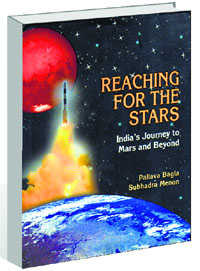Reviewed by Kuldip Singh Dhir
Indian missions to the Moon and Mars weren’t welcomed by some critics. Their plea was that these are unnecessary luxuries to indulge in. There is, however, a different perspective to it. India spends 0.34 per cent of its national budget on space programmes. Of this 7.5 per cent is allocated for space exploration and its benefits are tremendous. Take disaster management for example. Few years back, approximately 10,000 lives were lost each year due to cyclones. The figure has now been reduced to single or double digits with the aid of satellite technology.
Direct and indirect benefits of scientific and technological developments necessitated the Mars Orbiter Mission (MOM) or Mangalyaan. Exploring the planet with the ultimate aim of colonising it is certainly the next-big thing for nations to stake claims of its rich resources or to find answers to the riddle of life in outer space. Pallava Bagla and Subhadra Menon have come up with the scintillating story of 15-month long journey of 690 kilometers, which made the country proud by giving the world its cheapest Mars probe.
The dramatic description starts with 56-hour countdown of MOM carrying PSLV-C-25 at 6am on November 3, 2013. The scene inside the mission control centre at Sriharikota Range is well created. It has been contrasted with the modest launch of Nike Apache on November 21, 1963 at 6pm from Thumba. The two events, 50 years apart have been used to weave a picture of India's space achievements and ambitions. The whole gamut of India's space programme, its humble beginnings, struggle of dreamers like Bhabha and Sarabhai, hard-working scientists transporting rockets on cycles and bullock carts, development of launch vehicles, numerous satellites, infrastructure and finally everything required for deep-space probes have been covered in the book.
The authors tell how the spur for going to Mars came from Dr. Manmohan Singh's Independence Day speech on August 15, 2012. Earlier, India's Chanderyan Mission took five years to materialise, allowing China to beat India in the run for Moon. Before giving details about the India’s Mars mission, a brief history of efforts to unravel Martian mysteries has been written about. Right from 1610 AD when Galileo turned his telescope to the sky to two billion-dollar Mars Curiosity rover, it can be observed that passion to explore the planet increased with the passage of time.
What follows is the story of frugal Indian technology. MOM was designed as the smallest independent and reliable satellite to carry out assigned jobs while orbiting Mars. The launch vehicle, various rocket motors, and technology to maneuver its path to put it in different orbits at precise moments were indigenously designed. No less important was the task of keeping track of MOM and managing data for which deep-space network at Byalalu was used. Five scientific payloads were sent on board MOM.
Our space dreams have not ended with Moon or Mars missions. PSLV has expanded its horizon from 800 kg payload to 1500 kg in last 20 years. Moving ahead, ISRO is now developing a monster rocket — GSLV that is taller than a 15-storey building and can lift 2500 kg satellites into deep space. It has outsourced work to 400 industrial firms, leaving its scientists and technologists free for cutting-edge research and design assignment.
Coming to MOM again, the authors have written about men and women behind our Mars mission. These include K.Radhakrishnan, M.Annadurai, S. Arunan, P.Kunhikrishnan, J.N. Goswami and D.R. Suma. Their efforts have enabled Indian MOM to be a part of the Mars elite club. We are in the company of Mars Express, Mars Reconnaissance orbiter, Curiosity, Opportunity, Spirit and MAVEN.
There are plans to collaborate with Israel and NASA as well. Commercialisation of satellite launches is on the cards. Our Chanderyan-2 hopes to land a rover on the Moon in the near future. Our solar probe Aditya-1 is being readied to fly into the face of the sun to study solar corona. The book tells that manned-space missions, Indian-space shuttle and space-capsule recovery are some other challenges before ISRO. Coloured pictures of the past and present accomplishments of Indian space missions make it an informative and valuable coffee-table book.










